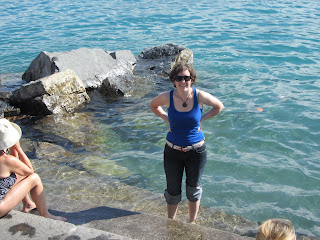I think I'm going to go in reverse chronological order, because I want to leave the physics for last. Sunday was a breathtaking experience (almost literally). We visited Chamonix, which lies in France, at the foot of Mont Blanc.
The church clock tower in Chamonix
Reaching the summit.
The pictures just don't do it justice. And to see all the people that are climbing the mountain- it's fantastic.
Mountaineers.
Even though I knew it would be, I was still surprised at how much thinner the air would be up there. Going up just a few stairs made me feel completely out of breath. |
| Mont Blanc (slightly hidden) |
 |
| At 3842 meters, with the TRU moose! |
Looking back down at the main platform
We also had a beautiful, sunny Saturday driving around Lake Geneva, and visiting the beautiful cities along the way. After lunch at the Mont Blanc hotel in Morges...
Family at Morges
...we continued on to Montreux. Apart from all the expensive casinos, and amazing lake views, Montreux is also home to a Freddie Mercury memorial, unveiled in 1996, due to Mountain Studios where Queen recorded some of their songs, but also because of Mercury's love of the city. I can see why, too!
Vineyards on the way to Montreux.
Freddie Mercury- "Lover of Life, Singer of Songs"
The mountain views
The fantastic Lake Geneva.
The houses in Yvoire.
I also noticed another very interesting statue when leaving the town. Mostly, I noticed because what looked like graffiti on the base was actually a series of physics equations and notes. This statue, is supposed to represent the recent discovery of the Higgs boson! That actually brings me to a more work related topic.
The Higgs boson- personified.
http://arxiv.org/pdf/1207.2146v2.pdf
Beware - there is math involved!
Now, according to the Standard Model (the model that we use to describe the electromagnetic, strong and weak forces as well as particle interactions through these forces) each of the forces is mediated by an associated particle (which are called bosons). For example, let's say we have two electrons come together. Everyone learns in high school that like charges repel, but this repulsion is not just "magic". The Standard Model says that the repulsion is actually caused by one electron emitting one of these mediating particles, a photon in this case, and the other absorbing it. For the strong and weak forces, they are mediated by the W and Z bosons. However, the photon is massless, the W and Z are very heavy (Z is around 90 GeV. **Just a note- GeV is one billion eV, the energy of one electron accelerated across a 1V potential (like a 1V battery). However, in particle physics, because of Einstein's E=mc^2, it is used as a measure of mass). A huge question was, why this difference? This is where the Higgs boson became important; it was introduced to explain why certain particles are very heavy while other are light. In the simplest terms, it has to do with how much the particles "like" the field- I always like the dinner party analogy
http://www.exploratorium.edu/origins/cern/ideas/cartoon.html
The big problem was, though this theory could predict how the field would cause particles to have mass as well as how the Higgs boson could possibly decay (break up into other particles), it said nothing about how heavy it was. So, for approximately the last 30 years, first with LEP (Large Electron -Positron collider) and SLAC (Stanford Linear Accelerator Center) and now with the LHC (Large Hadron Collider), experimentalists have been searching for evidence. Based on the models we have, physicists had to comb through a very wide range of masses, and using what we know about how the boson should decay, they could determine (statistically) whether or not the data showed any excess. I may go into what this "excess" is a bit later. For now, it is enough to say that a lot of processes can mimic the Higgs boson (known as background) and the real boson would look like some extra Higgs signal- a bump- exceeding what we expect from the background.
After after years of ruling out various mass regions, physicists have finally found that "bump". Now, it's just a matter of seeing whether or not the data agrees completely with the theory in terms of charge, something known as spin, and other properties we would expect the Higgs boson to have.












No comments:
Post a Comment